The Gestalt System is a psychological theory that focuses on the human perception of the world and how individuals make sense of their surroundings. It was developed in the early 20th century by a group of German psychologists who believed that the whole is greater than the sum of its parts. This theory has had a significant impact on the fields of psychology, philosophy, and art, and its principles continue to be studied and applied today. In this essay, we will explore the fundamental principles of the Gestalt System and how they shape our understanding of the world and ourselves.
The key principles of Gestalt systems are Emergence, Reification, Multistability and Invariance.
Emergence
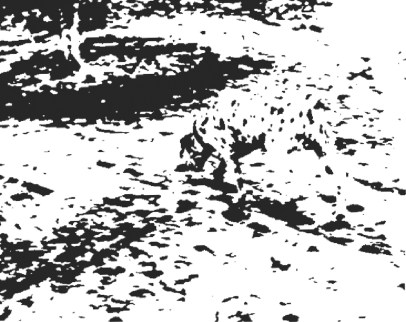
Emergence is the process of complex pattern formation from simpler rules. It is demonstrated by the perception of the Dog Picture, which depicts a Dalmatian dog sniffing the ground in the shade of overhanging trees. The dog is not recognized by first identifying its parts (feet, ears, nose, tail, etc.), and then inferring the dog from those component parts. Instead, the dog is perceived as a whole, all at once. However, this is a description of what occurs in vision and not an explanation. Gestalt theory does not explain how the percept of a dog emerges.
Reification
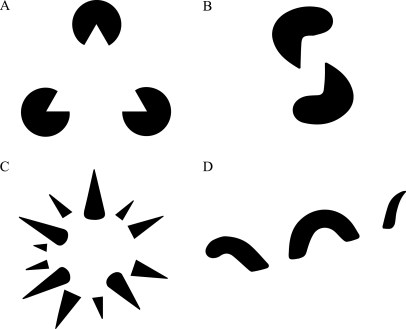
Reification is the constructive or generative aspect of perception, by which the experienced percept contains more explicit spatial information than the sensory stimulus on which it is based. For instance, a triangle will be perceived in picture A, although no triangle has actually been drawn. In pictures B and D the eye will recognize disparate shapes as “belonging” to a single shape, in C a complete three-dimensional shape is seen, where in actuality no such thing is drawn. Reification can be explained by progress in the study of illusory contours, which are treated by the visual system as “real” contours.
Multistability
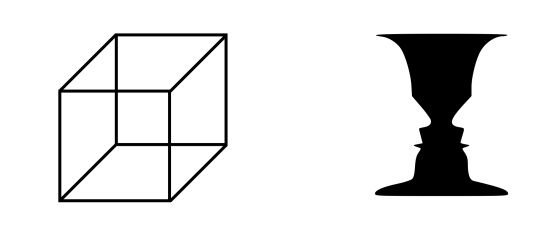
Multistability (or multistable perception) is the tendency of ambiguous perceptual experiences to pop back and forth unstably between two or more alternative interpretations. This is seen for example in the Necker cube, and in Rubin’s Figure/Vase illusion shown here. Other examples include the Three-legged blivet and artist M. C. Escher’s artwork and the appearance of flashing marquee lights moving first one direction and then suddenly the other. Again, Gestalt does not explain how images appear multistable, only that they do.
Invariance
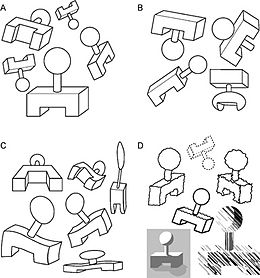
Invariance is the property of perception whereby simple geometrical objects are recognized independent of rotation, translation, and scale; as well as several other variations such as elastic deformations, different lighting, and different component features. For example, the objects in A in the figure are all immediately recognized as the same basic shape, which are immediately distinguishable from the forms in B. They are even recognized despite perspective and elastic deformations as in C, and when depicted using different graphic elements as in D. Computational theories of vision, such as those by David Marr, have had more success in explaining how objects are classified.
Emergence, reification, multistability, and invariance are not necessarily separable modules to be modeled individually, but they could be different aspects of a single unified dynamic mechanism.
Prägnanz
In perception, there are many organizing principles called gestalt laws. The most general version is called the law of pragnanz. Pragnanz is German for pregnant, which says that we tend to order our experience in a manner that is regular, orderly, symmetric, and simple. Gestalt psychologists attempt to discover refinements of the law of prägnanz, and this involves writing down laws which hypothetically allow us to predict the interpretation of sensation, what are often called “gestalt laws”. These include:
Law of Closure

Law of Similarity
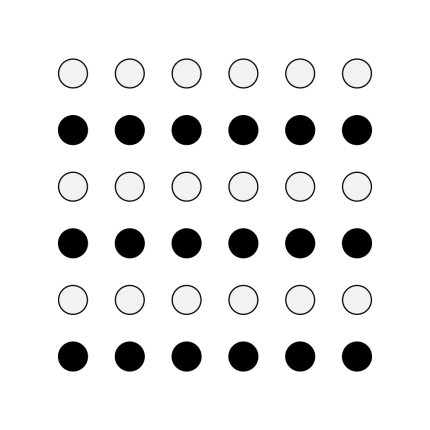
Law of Proximity

- Law of Closure — The mind may experience elements it does not perceive through sensation, in order to complete a regular figure (that is, to increase regularity).
- Law of Similarity — The mind groups similar elements into collective entities or totalities. This similarity might depend on relationships of form, color, size, or brightness.
- Law of Proximity — Spatial or temporal proximity of elements may induce the mind to perceive a collective or totality.
- Law of Symmetry (Figure ground relationships)— Symmetrical images are perceived collectively, even in spite of distance.
- Law of Continuity — The mind continues visual, auditory, and kinetic patterns.
- Law of Common Fate — Elements with the same moving direction are perceived as a collective or unit.
But the gestalt principles are by no means restricted to perception — that’s just where they were first noticed. Take, for example, memory. That too seems to work by these laws. If you see an irregular saw-tooth figure, it is likely that your memory will straighten it out for you a bit. Or, if you experience something that doesn’t quite make sense to you, you will tend to remember it as having meaning that may not have been there. A good example is dreams: Watch yourself the next time you tell someone a dream and see if you don’t notice yourself modifying the dream a little to force it to make sense!
Learning was something the Gestalt psychologists were particularly interested in. One thing they noticed right away is that we often learn, not the literal things in front of us, but therelations between them. For example, chickens can be made to peck at the lighter of two gray swatches. When they are then presented with another two swatches, one of which is the lighter of the two preceding swatches, and the other a swatch that is even lighter, they will peck not at the one they pecked at before, but at the lighter one! Even something as stupid as a chicken “understands” the idea of relative lightness and darkness.
Gestalt theory is well known for its concept of insight learning. People tend to misunderstand what is being suggested here: They are not so much talking about flashes of intuition, but rather solving a problem by means of the recognition of a gestalt or organizing principle.
The most famous example of insight learning involved a chimp named Sultan. He was presented with many different practical problems (most involving getting a hard-to-reach banana). When, for example, he had been allowed to play with sticks that could be put together like a fishing pole, he appeared to consider in a very human fashion the situation of the out-of-reach banana thoughtfully — and then rather suddenly jump up, assemble the poles, and reach the banana.
A similar example involved a five year old girl, presented with a geometry problem way over her head: How do you figure the area of a parallelogram? She considered, then excitedly asked for a pair of scissors. She cut off a triangle from one end, and moved it around to the other side, turning the parallelogram into a simple rectangle. Wertheimer called this productive thinking.
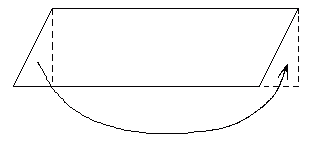
The idea behind both of these examples, and much of the gestalt explanation of things, is that the world of our experiencing is meaningfully organized, to one degree or another. When we learn or solve problems, we are essentially recognizing meaning that is there, in the experience, for the “dis-covering.”
Most of what we’ve just looked at has been absorbed into “mainstream” psychology — to such a degree that many people forget to give credit to the people who discovered these principles! There is one more part of their theory that has had less acceptance: Isomorphism. Isomorphism suggests that there is some clear similarity in the gestalt patterning of stimuli and of the activity in the brain while we are perceiving the stimuli. There is a “map” of the experience with the same structural order as the experience itself, albeit “constructed” of very different materials! We are still waiting to see what an experience “looks” like in an experiencing brain. It may take a while.
Gestalt views in Psychology
Gestalt psychologists find it is important to think of problems as a whole. Max Wertheimer considered thinking to happen in two ways: productive and reproductive.
- Productive thinking is solving a problem with insight. This is a quick insightful unplanned response to situations and environmental interaction.
- Reproductive thinking is solving a problem with previous experiences and what is already known. (1945/1959).
This is a very common thinking. For example, when a person is given several segments of information, he/she deliberately examines the relationships among its parts, analyzes their purpose, concept, and totality, he/she reaches the “aha!” moment, using what is already known. Understanding in this case happens intentionally by reproductive thinking.
Other Gestalts psychologist Perkins believes insight deals with three processes:
- Unconscious leap in thinking.
- The increased amount of speed in mental processing.
- The amount of short-circuiting which occurs in normal reasoning.
Other views going against the Gestalt psychology are:
- Nothing-Special View
- Neo-Gestalts View
- The Three-Process View
Gestalt psychology should not be confused with the Gestalt therapy of Fritz Perls, which is only peripherally linked to Gestalt psychology. A strictly Gestalt psychology-based therapeutic method is Gestalt Theoretical Psychotherapy, developed by the German Gestalt psychologist and psychotherapist Hans-Jürgen Walter.
Uses in Human–Computer Interaction
The Gestalt laws are used in user interface design. The laws of similarity and proximity can, for example, be used as guides for placing radio buttons. They may also be used in designing computers and software for more intuitive human use. Examples include the design and layout of a desktop’s shortcuts in rows and columns. Gestalt psychology also has applications in computer vision for trying to make computers “see” the same things as humans do. James J. Gibson was a Gestalt Psychologist who focused on vision and what he termed ecological perception. He also coined the term affordance which has been productive of various human factors and usability research.
Criticism
In some scholarly communities, such as cognitive psychology and computational neuroscience, Gestalt theories of perception are criticized for being descriptive rather than explanatory in nature. For this reason, they are viewed by some as redundant or uninformative. For example, Bruce, Green & Georgeson conclude the following regarding Gestalt theory’s influence on the study of visual perception:
“The physiological theory of the Gestaltists has fallen by the wayside, leaving us with a set of descriptive principles, but without a model of perceptual processing. Indeed, some of their “laws” of perceptual organisation today sound vague and inadequate. What is meant by a “good” or “simple” shape, for example?”